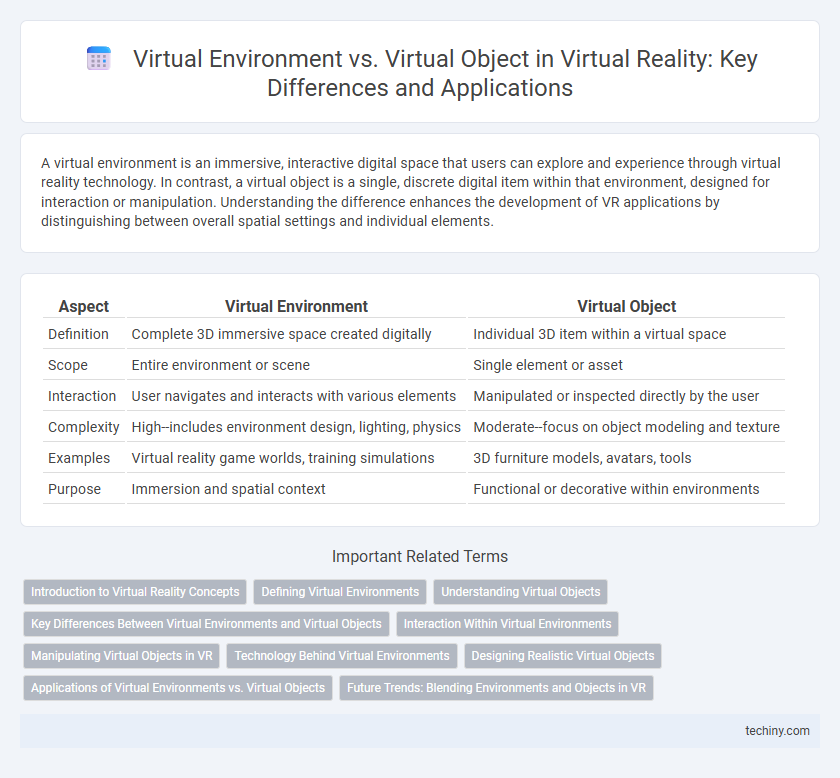A virtual environment is an immersive, interactive digital space that users can explore and experience through virtual reality technology. In contrast, a virtual object is a single, discrete digital item within that environment, designed for interaction or manipulation. Understanding the difference enhances the development of VR applications by distinguishing between overall spatial settings and individual elements.
Table of Comparison
| Aspect | Virtual Environment | Virtual Object |
|---|---|---|
| Definition | Complete 3D immersive space created digitally | Individual 3D item within a virtual space |
| Scope | Entire environment or scene | Single element or asset |
| Interaction | User navigates and interacts with various elements | Manipulated or inspected directly by the user |
| Complexity | High--includes environment design, lighting, physics | Moderate--focus on object modeling and texture |
| Examples | Virtual reality game worlds, training simulations | 3D furniture models, avatars, tools |
| Purpose | Immersion and spatial context | Functional or decorative within environments |
Introduction to Virtual Reality Concepts
Virtual environments are immersive, computer-generated spaces where users can interact with a fully simulated world, enhancing sensory experiences through VR headsets and motion tracking. Virtual objects are individual digital items within these environments, designed to be manipulated or interacted with, contributing to the realism and functionality of the virtual space. Understanding the distinction between virtual environments and virtual objects is fundamental to developing effective VR applications and user experiences.
Defining Virtual Environments
Virtual environments are immersive, computer-generated spaces designed to simulate real-world or imaginary settings, allowing users to interact within a fully navigable 3D world. Unlike virtual objects, which are individual digital items or entities, virtual environments encompass a comprehensive spatial context where multiple virtual objects coexist and interact dynamically. Defining virtual environments involves understanding their role in providing sensory experiences through visual, auditory, and sometimes haptic feedback to create a believable, interactive realm.
Understanding Virtual Objects
Virtual objects are discrete, interactive elements within a virtual environment, designed to mimic real-world counterparts through 3D modeling and physics-based behavior. Unlike the encompassing virtual environment that provides the contextual space, virtual objects offer tangible points of interaction, such as tools, avatars, or furniture. Mastery of virtual objects enhances user immersion by enabling realistic manipulation, spatial awareness, and dynamic feedback within the virtual reality ecosystem.
Key Differences Between Virtual Environments and Virtual Objects
Virtual environments are immersive, interactive digital spaces designed to simulate real or imagined worlds, while virtual objects are individual items within these spaces that users can manipulate or interact with. Key differences include the scope and scale: virtual environments encompass the entire simulated scene, integrating multiple sensory inputs, whereas virtual objects are discrete entities with specific properties and functions. Interaction within virtual environments involves navigation and spatial awareness, whereas virtual objects focus on manipulation, usability, and user-object interaction.
Interaction Within Virtual Environments
Interaction within virtual environments hinges on the distinction between virtual environments and virtual objects, where virtual environments refer to immersive, computer-generated spaces users can explore, while virtual objects are discrete digital items within these spaces that users can manipulate. Effective interaction design incorporates haptic feedback, gesture recognition, and spatial audio to enhance the realism of engagements with virtual objects, enabling intuitive user experiences. Immersive technologies such as VR headsets and motion controllers facilitate seamless navigation and manipulation, bridging the gap between physical actions and virtual responses in the environment.
Manipulating Virtual Objects in VR
Manipulating virtual objects in virtual reality involves direct interaction within a fully immersive virtual environment designed to simulate real-world physics and spatial relationships. Virtual objects, unlike static elements, respond dynamically to user input such as grabbing, rotating, or resizing, enhancing the realism and intuitive control within the VR space. Advanced VR systems leverage haptic feedback and precise motion tracking to improve object manipulation accuracy, fostering greater user engagement and task efficiency.
Technology Behind Virtual Environments
Virtual environments rely on advanced technologies such as real-time rendering engines, spatial audio systems, and haptic feedback devices to create immersive, interactive digital spaces. These environments integrate complex algorithms for tracking user movements and generating dynamic, multi-sensory experiences that respond to user input. In contrast, virtual objects are individual digital entities designed with 3D modeling software and programmed with specific behaviors, but they fundamentally depend on the broader virtual environment infrastructure to provide context and interactivity.
Designing Realistic Virtual Objects
Designing realistic virtual objects requires meticulous attention to texture, lighting, and physics properties to ensure seamless integration within virtual environments. High-fidelity 3D modeling combined with advanced rendering techniques like ray tracing enhances object realism and user immersion. Effective interaction design further bridges the gap between virtual objects and users, fostering intuitive and believable experiences in virtual reality.
Applications of Virtual Environments vs. Virtual Objects
Virtual environments offer immersive experiences used in training simulations, therapeutic settings, and educational platforms by replicating entire spaces for users to explore. Virtual objects serve as interactive elements within these environments, enabling detailed manipulation and specific task performance, such as virtual prototyping or medical visualization. The combination of virtual environments and virtual objects enhances user engagement and practical applications across industries like gaming, healthcare, and design.
Future Trends: Blending Environments and Objects in VR
Future trends in virtual reality emphasize seamless integration between virtual environments and virtual objects, enhancing user immersion and interaction fidelity. Advances in spatial computing and AI-driven object manipulation enable dynamic, context-aware virtual objects that adapt fluidly within expansive virtual environments. This convergence fosters hyper-realistic experiences, paving the way for applications in training, gaming, and remote collaboration.
Virtual Environment vs Virtual Object Infographic

 techiny.com
techiny.com